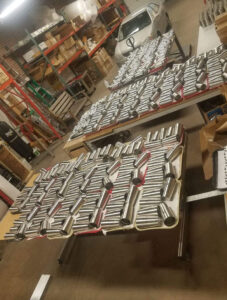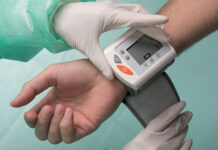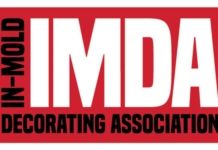by Lara Copeland, writer, Plastics Decorating
Businesses have much to wrestle with when considering the optimal layout of their production facilities. From managing available space, to managing the workflows of both materials and their handlers, to addressing safety needs, companies must be flexible as demands and requirements seem to be constantly in motion. But, can these demands be balanced in such a way to also maximize productivity and profit?
Critical components in shop floor layout

The layout of a shop floor is vital to reducing production costs while increasing productivity. When arranged optimally, work-in-process can decrease, as can material-handling and total production costs. President of Pad Print Pros in Onsted, Michigan, John Kaverman has been inside plenty of shops and has identified the key to efficient workflow: minimizing human contact and material-handling steps (labor). Additionally, he said it is essential to know where scrap is occurring.
In Steve Langer’s pad printing shop, Langer Printing, Skokie, Illinois, the environment is one that is constantly changing. “We never know what kind of merchandise we’ll receive, so something as simple as creating space for whatever may come in is important for us to consider,” Langer said. “In the beginning of production, when we’re unpacking the job and figuring out the stages, we have to keep the area cordoned off so everything stays organized in stages.” Keeping the workflow “circular,” according to Langer, helps the shop keep everything orderly.
Tim Curnutt, president of Distinctive Plastics, Inc. (DPI), Vista, California, highlighted four key elements to DPI’s shop floor layout: adequate workspace, traffic control, accountability of movements and cleanroom environments.
He explained first, “Real estate is premium in a manufacturing plant, so you don’t want to waste it. At the same time, cramped workspace leads to decreased productivity, so you have to make a balance between the two and organize the workspace so that the least number of steps is required to accomplish the job.”
Next, he said that his shop is set up so that all raw materials flow from the warehouse via the back of the building and finished goods flow via the front side to relieve congestion. Furthermore, all raw materials, works in progress and finished goods have a location assigned through DPI’s material requirement planning (MRP) system, and every movement is tracked in that system via barcode scanning.
Lastly, cleanroom environments pose workflow challenges as well. “At DPI, we have several Class 5 workcell environments,” Curnutt stated. Having adequate space to properly operate around the work cell is important, as is having adequately cleaned packaging environments.
Preplanning for decorating
Preplanning for a job before it appears on the shop floor for decoration allows for it to be started immediately upon arriving. In fact, long before a new job lands on DPI’s floor, its engineers already have put in extensive time studying the project in a 3D environment. “We have modeled the workcells and equipment in finite detail, so we can load the 3D models of the molds and decoration into the environment assuring that it all lines up and that we have adequate room for the automation,” Curnutt stated.
Kaverman has seen multiple examples of effective pre-planning strategies in various shops. He said that knowing where scrap is coming from upstream is helpful in identifying whether it makes sense to complete other value-added processes before or after decorating. This potentially eliminates unnecessary material handling/labor.
“If there is a series of parts moving through the decorating area but only some of the parts receive printing (decorating),” he said, “it is a good idea to evaluate how you can most efficiently keep parts together.”
For example, if a part has two halves that may be separated because only one half needs decorated, then including a staging area where parts can be separated in an orderly fashion helps ensure matching parts come back together after decorating is complete.
Langer Printing puts together a digital mock-up once the artwork and purchase order are received. “We don’t need to wait until the merchandise comes in to do the mock-up,” Langer remarked. “Our prep really goes into being prepared for a job to come in and make sure it gets done in a timely fashion to be ahead of the game. Typically all we have to do is unpack the merchandise and it’s ready to print.”
Overcoming challenges impacting productive workflow
The industry is no stranger to challenges in keeping a productive workflow on the shop floor. More importantly, it is familiar with using ingenuity to overcome those challenges. Langer Printing constantly is presented with challenges. “From eight in the morning until five at night, that’s all I do,” Langer joked. But he has found that keeping the operation flowing has helped his shop floor avoid issues with space.
“We have overcome this issue by getting everything lined up so we can unpack, get items to the machine, print it, cure it and repack at the same time.” In other words, “we don’t unpack the whole job, then stop and print – everything is done simultaneously, which cuts the needed space in half,” he said.
In the constant battle to stay ahead of the competition and meet deadlines, all while keeping customers happy, some shops have had to figure out how to stay organized and on top of material supplies.
According to Curnutt, one of the biggest challenges to a productive workflow these days is material shortages. “Many of our raw materials that used to be one-week lead times are now stretching out as far as 16 to 18 weeks,” he said. “Many materials are on allocation, and some we simply can no longer get – and it’s the same way for maintenance items as well.” Curnutt reported that 14% of DPI’s late deliveries in the first two months of the year could be attributed to material shortages and supplier issues, and that jumped to 46% by March.
“We have found that during these times, communication is even more important than normal,” he said. He suggested talking to customers, letting them know of the issues with the supply chain and also encouraging them to putting their orders in early. Additionally, he said it would be wise to check back with suppliers often to find out the order’s status.
Kaverman offered several tips for keeping the work floor productive – for instance, keeping materials organized. Looking for tools, fixtures, consumables, etc. can cause unnecessary loss of time, so he suggested keeping all necessary tools readily available for operators. “Keeping a dedicated toolbox is essential,” Kaverman said. He also explained that creating kits for individual jobs is a good idea.
“An example of a kit for pad printing would include the part-specific nesting fixture(s); master parts (approved for image location, for example, and clearly tagged to prevent them from entering the production stream); cliché plates, pads and pad stems cut to appropriate length to reduce stroke distances; and set-up sheets with ink formulas, pad numbers, cliché/artwork file numbers and machine parameters/program numbers.” He added that these kits are a great time saver, but most people don’t think of creating them.
Kaverman also advised communicating via a board or other visual aid to clearly depict bad parts, their potential causes and remedies for the failures.
Furthermore, he explained that when problems arise, it may be helpful if production/engineering/supervisory personnel are able to use smartphones to take pictures or videos of machine cycles and process defects to share with the equipment manufacturer’s technical personnel via email. Otherwise, he warned, “It is incredibly difficult to diagnose a problem when you cannot see what is going on or the persons describing the problem can’t clearly explain what they are seeing.”
Creating a safe work environment
Promoting safety on the shop floor is a continual concern. And despite all considerations taken, accidents still happen. To prevent loss of production and, more importantly, loss of limb or life, ensuring worker protection is key.
Kaverman noted simple solutions like plunger cans for safely dispensing clean-up solvents, anti-slip mats for operators working on concrete flooring, sufficient lighting and adequate ventilation. He also emphasized the importance of proper training for operators and having equipment manuals readily available.
DPI runs a 24-hour operation and uses standardized workstations to reduce wasted movement, repetitive injuries and fatigue. “More and more we use robotics and automation to eliminate repetitive motion injuries,” Curnutt said. “In fact, of our 27 molding machines, 21 of them are robotic workcells, with more on order.”
The shop also has two floating collaborative robots, called cobots, that can assist on any machine and several pieces of automation for specific jobs.
He added, “You still have to make sure to design adequate guarding around the automation to protect the people.” He reported that with increased automation industrial accidents have decreased while the cycle consistency and quality have increased.
Safety concerns took on an added layer last year when the COVID-19 pandemic came onto the scene. Langer Printing already had safety precautions in place – like fire extinguishers and safety kits – prior to 2020, but it has since added extra safety measures.
In addition to sanitizing everything and asking employees to wear masks and gloves, Langer reported that handling is kept to a minimum. “We want to really be on the ball when it comes to safety,” he said.
Conclusions
Facilities consider many important elements regarding the layout of their shop floors to help create a productive work environment. From the preplanning stage to safety measures, there are multiple opportunities to overcome the various challenges organizations may face in trying to keep a productive workflow on the shop floor.
With varying production requirements, due dates and lead times, increasing productivity may be difficult but not impossible.





